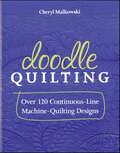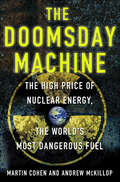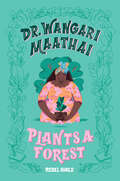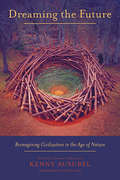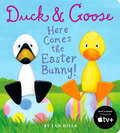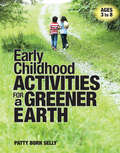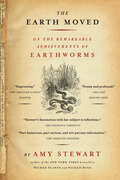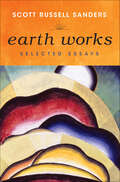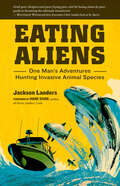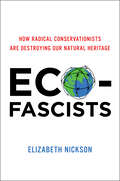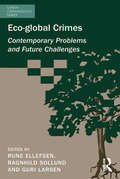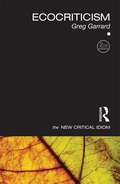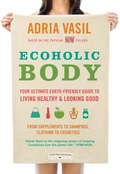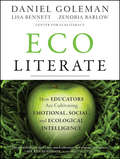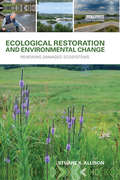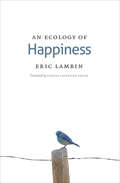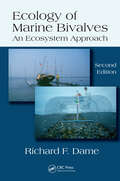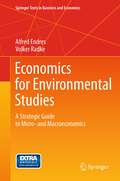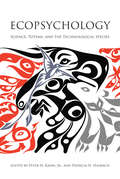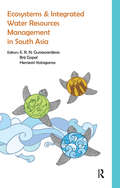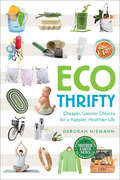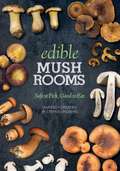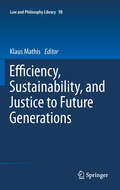- Table View
- List View
Doodle Quilting: Over 120 Continuous-Line Machine-Quilting Designs
by Cheryl MalkowskiLearn to draw...with your sewing machine! In this beginner's guide to free-motion, continuous-line quilting designs, the focus is on selecting the right forms and lines that get you where you need to go...because sometimes the hardest part is figuring out where to quilt next! You'll gain confidence in your innate artistic ability to draw basic shapes, then you'll learn how to put them together into over a hundred different all-over quilting designs. • See how easy it can be to create interesting quilting designs by mastering your doodling skills • From squiggles and swirls to flowers and feathers, learn which shapes are best for confined spaces and which work better traveling across your quilt • Includes drawing exercises and tips for transferring your designs from paper to fabric
The Doomsday Machine: The High Price of Nuclear Energy, the World's Most Dangerous Fuel
by Martin Cohen Andrew McKillopToday, there are over one hundred nuclear reactors operating in our backyards, from Indian Point in New York to Diablo Canyon in California. Proponents claim that nuclear power is the only viable alternative to fossil fuels, and due to rising energy consumption and the looming threat of global warming, they are pushing for an even greater investment. Here, energy economist Andrew McKillop and social scientist Martin Cohen argue that the nuclear power dream being sold to us is pure fantasy. Debunking the multilayered myth that nuclear energy is cheap, clean, and safe, they demonstrate how landscapes are ravaged in search of the elusive yellowcake to fuel the reactors, and how energy companies and politicians rarely discuss the true costs of nuclear power plants - from the subsidies that build the infrastructure to the unspoken guarantee that the public will pick up the cleanup cost in the event of a meltdown, which can easily top $100 billion dollars.
Dr. Wangari Maathai Plants a Forest (Rebel Girls Chapter Books)
by Rebel Girls Corinne PurtillFrom the world of Good Night Stories for Rebel Girls comes a historical novel based on the life of Dr. Wangari Maathai, the Nobel Peace Prize-winning activist and environmentalist from Kenya.Wangari lives in the lush, green, land of rural Kenya where the soil is perfect for planting, the trees tower into the sky, and the streams are full of mysterious creatures. All day, she plays beneath her favorite fig tree, and at night she gathers around the fire with her family to listen to her mother's stories.Then Wangari grows up and goes away to school, and things start changing at home. Farmers chop down the trees. Landslides bury the stream. The soil becomes overworked and dry, and nothing will grow. People go hungry. After all her studies, Dr. Wangari Maathai realizes there is a simple solution to these problems: plant a forest full of trees.Dr. Wangari Maathai Plants a Forest is the story of environmentalist and activist Dr. Wangari Maathai, who became the first African woman to receive the Nobel Peace Prize. It's also a story about the importance of making your voice heard, and using that voice to protect the natural world.This historical fiction chapter book includes additional text on Dr. Wangari Maathai's lasting legacy, as well as educational activities designed to encourage caring for the planet and believing in the power of one.About the Rebel Girls Chapter Book SeriesMeet extraordinary real-life heroines in the Good Night Stories for Rebel Girls chapter book series! Introducing stories based on the lives of extraordinary women in global history, each stunningly designed chapter book features beautiful illustrations from a female artist as well as bonus activities in the backmatter to encourage kids to explore the various fields in which each of these women thrived. The perfect gift to inspire any young reader!
Dreaming the Future: Reimagining Civilization in the Age of Nature
by David W. Orr Kenny AusubelFew would deny that we are entering a period of great change. Our environment is collapsing. Social disruption abounds. All around, it seems, we are experiencing breakdown. But out of this chaos comes the opportunity for breakthrough-the opportunity to reimagine our future. In Dreaming the Future, Kenny Ausubel leads us into that possible new world and introduces us to the thinkers and doers who are-sometimes quietly, sometimes not-leading what he calls "a revolution from the heart of nature and the human heart." In a collection of short, witty, poignant, even humorous essays, Ausubel tracks the big ideas, emerging trends, and game-changing developments of our time. He guides us through our watershed moment, showing how it's possible to emerge from a world where corporations are citizens, the gap between rich and poor is cavernous, and biodiversity and the climate are under assault and create a world where we take our cues from nature and focus on justice, equity, diversity, democracy, and peace. Even those steeped in the realities of a world gone wrong and efforts to right it will find refreshing, even surprising, perspectives in Dreaming the Future. It will come as no surprise to readers that Ausubel is cofounder of Bioneers-which foreword author David W. Orr describes as "one part global salon...one part catalytic organization."
Duck & Goose, Here Comes the Easter Bunny! (Duck & Goose)
by Tad HillsDuck & Goose are back! New York Times bestselling author and illustrator Tad Hills brings our favorite feathered friends out to celebrate spring in this sturdy board book. Duck & Goose have lots of ideas about how to find the Easter Bunny, but will they succeed? Preschoolers won't be able to resist this latest board book featuring Duck & Goose, lots of colorful eggs, and the Easter Bunny.From the Board edition.
Early Childhood Activities for a Greener Earth
by Patty Born SellyMore than 100 classroom activities to help children learn about and care for the earthEducate young children about the environment through experience and play. These activities encourage children to develop a sense of wonder, curiosity, and joy for nature. Each chapter focuses on a common and important environmental topic-from waste reduction and recycling to air quality, weather and climate change, and energy reduction-and provides information to help you present these topics to children in developmentally appropriate ways. Early Childhood Activities for a Greener Earth will help you excite children, engage families, and encourage your community to be green.Early Childhood Activities for a Greener Earth is a 2014 Teachers' Choice Award for the Classroom winner!
The Earth Moved: On the Remarkable Achievements of Earthworms
by Amy StewartIn The Earth Moved, Amy Stewart takes us on a journey through the underground world and introduces us to one of its most amazing denizens. The earthworm may be small, spineless, and blind, but its impact on the ecosystem is profound. It ploughs the soil, fights plant diseases, cleans up pollution, and turns ordinary dirt into fertile land. Who knew? <P><P>In her witty, offbeat style, Stewart shows that much depends on the actions of the lowly worm. Charles Darwin devoted his last years to the meticulous study of these creatures, praising their remarkable abilities. With the august scientist as her inspiration, Stewart investigates the worm's subterranean realm, talks to oligochaetologists—the unsung heroes of earthworm science—who have devoted their lives to unearthing the complex life beneath our feet, and observes the thousands of worms in her own garden. <P> From the legendary giant Australian worm that stretches to ten feet in length to the modest nightcrawler that wormed its way into the heart of Darwin's last book to the energetic red wigglers in Stewart's compost bin, The Earth Moved gives worms their due and exposes their hidden and extraordinary universe. This book is for all of us who appreciate Mother Nature's creatures, no matter how humble.
Earth Works: Selected Essays
by Scott Russell SandersIn the hands of award-winning writer Scott Russell Sanders, the essay becomes an inquisitive and revelatory form of art. In 30 of his finest essays—nine never before collected—Sanders examines his Midwestern background, his father's drinking, his opposition to war, his literary inheritance, and his feeling for wildness. He also tackles such vital issues as the disruption of Earth's climate, the impact of technology, the mystique of money, the ideology of consumerism, and the meaning of sustainability. Throughout, he asks perennial questions: What is a good life? How do family and culture shape a person's character? How should we treat one another and the Earth? What is our role in the cosmos? Readers and writers alike will find wisdom and inspiration in Sanders's luminous and thought-provoking prose.
Eating Aliens: One Man's Adventures Hunting Invasive Animal Species
by Hank Shaw Jackson LandersNorth America is under attack by a wide range of invasive animals, pushing native breeds to the brink of extinction. Combining thrilling hunting adventures, a keen culinary imagination, and a passionate defense of the natural environment, Eating Aliens chronicles Landers’ quest to hunt 12 invasive animal species and turn them into delicious meals. Get ready to dig into tacos filled with tasty black spiny-tailed iguana!
Eco-Fascists: How Radical Conservationists Are Destroying Our Natural Heritage
by Elizabeth NicksonForty million Americans have been driven from their lands and rural culture is being systematically crushed, even as wildlife, forests, and rangelands are dying. Journalist Elizabeth Nickson’s investigations into these events have revealed a shocking truth: rather than safeguarding our environment, radical conservationists are actually destroying our natural heritage. In Eco-Fascists, Nickson documents the destructive impact of the environmental movement in North America and beyond, detailing the extreme damage environmental radicals in local and national government agencies are doing to the land, the ecosystems, and the people. Readers of Alston Chase’s Playing God in Yellowstone and In a Dark Wood, and anyone who is deeply concerned about global warming and the environment must read Elizabeth Nickson’s Eco-Fascists.
Eco-global Crimes: Contemporary Problems and Future Challenges (Green Criminology)
by Ragnhild SollundBuilding on knowledge within the fields of green and eco-global criminology, this book uses empirical and theoretical arguments to discuss the multi-dimensional character of eco-global crime. It provides an overview of eco-global crimes and discusses them from a justice perspective. The persistence of animal abuse and speciesism are also examined together with policies aimed at controlling the natural world and plant species. Pollution by large corporations, rights of indigenous peoples and the damage caused by the mineral extraction are also considered. Providing new ideas and insights which will be relevant on a global scale, this book is an interesting and useful study of the exploitation of nature and other species. It will be invaluable for students and scholars globally, working within or connected to the field of green and eco-global criminology. The book will also be important for the participants of various social movements, especially the environmental and animal advocacy movements.
Ecocriticism (The New Critical Idiom)
by Greg GarrardEcocriticismexplores the ways in which we imagine and portray the relationship between humans and the environment in all areas of cultural production, from Wordsworth and Thoreau through to Google Earth, J. M. Coetzee and Werner Herzog's Grizzly Man. Greg Garrard's animated and accessible volume traces the development of the movement and explores its key concepts, including: pollution wilderness apocalypse dwelling animals earth. Featuring a newly rewritten chapter on animal studies, and considering queer and postcolonial ecocriticism and the impact of globalisation, this fully updated second edition also presents a glossary of terms and suggestions for further reading in print and online. Concise, clear, and authoritative, Ecocriticismoffers the ideal introduction to this crucial subject for students of literary and cultural studies.
Ecoholic Body: Your Ultimate Earth-friendly Guide to Living Healthy and Looking Good
by Adria VasilAdria Vasil, Canada's straight-shooting green living expert, is back, and this time it's personal . . . care, that is. Her latest eco bible delivers the lowdown on virtually every product that comes into contact with our bodies. From the pollutants clogging your sinus meds all the way to the outlaw toxins leaching from your sandals, ECOHOLIC BODY has you covered, head to toe. Never shy to blow the whistle, Adria calls out supplement and shampoo makers that exaggerate their green cred. This witty, indispensable guide will arm you with the knowledge you need to keep you and your family healthy, happy and green, all while detoxing the planet. Look your best- "Mean 15" ingredients to avoid- Skin care reviews for moisturizers, sunscreen, anti-aging and acne- Fresh ways to fight funk from bad breath to B.O.- Toxin-free hair care that works- The lowdown on mineral makeup, natural cosmetics, tattoos and more Feel your best- Nature's best remedies and superfoods that are good for the planet and your body- Greening your health care- Pollution-triggered health problems- Ecoholic weight loss plan- Greener birth control, local sex toys and more Dress your best- All the latest eco fashions, including activewear, maternity clothes, lingerie, menswear, footwear, jewellery, wedding dresses and more Give your kids nature's best- Toxin-free bum balms, shampoos, bubble bath, oils and powders- Green diaper reviews- The scoop on kids' PJs, clothes, charms And more- Exhaustive testing guides for everything from natural deodorant to herbal shampoos- Made-in-Canada products and services- Coast-to-coast store directory- DIY recipes for homemade body care- Money-saving tips in every chapterose hands touched? She rehearsed the questions she wondered if she would ever be able to ask. Why do you do it? Is it necessary to your poetry? Why did you choose this job? Or did it choose you?-- from The Murder RoomFrom the Hardcover edition.
Ecoliterate: How Educators Are Cultivating Emotional, Social, and Ecological Intelligence
by Daniel Goleman Lisa Bennett Zenobia BarlowA new integration of Goleman's emotional, social, and ecological intelligence Hopeful, eloquent, and bold, Ecoliterate offers inspiring stories, practical guidance, and an exciting new model of education that builds - in vitally important ways - on the success of social and emotional learning by addressing today's most important ecological issues. This book shares stories of pioneering educators, students, and activists engaged in issues related to food, water, oil, and coal in communities from the mountains of Appalachia to a small village in the Arctic; the deserts of New Mexico to the coast of New Orleans; and the streets of Oakland, California to the hills of South Carolina. Ecoliterate marks a rich collaboration between Daniel Goleman and the Center for Ecoliteracy, an organization best known for its pioneering work with school gardens, school lunches, and integrating ecological principles and sustainability into school curricula. For nearly twenty years the Center has worked with schools and organizations in more than 400 communities across the United States and numerous other countries. Ecoliterate also presents five core practices of emotionally and socially engaged ecoliteracy and a professional development guide.
Ecological Restoration and Environmental Change: Renewing Damaged Ecosystems
by Stuart K. AllisonWhat is a natural habitat? Who can define what is natural when species and ecosystems constantly change over time, with or without human intervention? When a polluted river or degraded landscape is restored from its damaged state, what is the appropriate outcome? With climate change now threatening greater disruption to the stability of ecosystems, how should restoration ecologists respond? Ecological Restoration and Environmental Change addresses and challenges some of these issues which question the core values of the science and practice of restoration ecology. It analyzes the paradox arising from the desire to produce ecological restorations that fit within an historical ecological context, produce positive environmental benefits and also result in landscapes with social meaning. Traditionally restorationists often felt that by producing restorations that matched historic ecosystems they were following nature's plans and human agency played only a small part in restoration. But the author shows that in reality the process of restoration has always been defined by human choices. He examines the development of restoration practice, especially in North America, Europe and Australia, in order to describe different models of restoration with respect to balancing ecological benefit and cultural value. He develops ways to balance more actively these differing areas of concern while planning restorations. The book debates in detail how coming global climate change and the development of novel ecosystems will force us to ask new questions about what we mean by good ecological restoration. When the environment is constantly shifting, restoration to maintain biodiversity, local species, and ecosystem functions becomes even more challenging. It is likely that in the future ecological restoration will become a never-ending, continuously evolving process.
Ecology and Revolution
by Carl BoggsEcology and Revolution: Global Crisis and the Political Challenge is an in-depth exploration and analysis of the global ecological crisis (going far beyond the issue of global warming) in the larger context of historical conditions and political options shaped by the failure (and incapacity) of the existing political system to adequately confront the crisis.
An Ecology of Happiness
by Eric LambinWe know that our gas-guzzling cars are warming the planet, the pesticides and fertilizers from farms are turning rivers toxic, and the earth has run out of space for the mountains of unrecycled waste our daily consumption has left in its wake. We've heard copious accounts of our impact--as humans, as a society--on the natural world. But this is not a one-sided relationship. Lost in these dire and scolding accounts has been the impact on us and our well-being. You sense it while walking on a sandy beach, or in a wild, woody forest, or when you catch sight of wildlife, or even while gardening in your backyard. Could it be that the natural environment is an essential part of our happiness? Yes, says Eric Lambin emphatically in An Ecology of Happiness. Using a very different strategy in addressing environmental concerns, he asks us to consider that there may be no better reason to value and protect the health of the planet than for our own personal well-being. In this clever and wide-ranging work, Lambin draws on new scientific evidence in the fields of geography, political ecology, environmental psychology, urban studies, and disease ecology, among others, to answer such questions as: To what extent do we need nature for our well-being? How does environmental degradation affect our happiness? What can be done to protect the environment and increase our well-being at the same time? Drawing on case studies from Asia, Africa, Europe, and North America, Lambin makes a persuasive case for the strong link between healthy ecosystems and happy humans. Unique in its scope and evenhanded synthesis of research from many fields, An Ecology of Happiness offers a compelling human-centered argument that is impossible to overlook when we marvel at murmurations of starlings or seek out the most brilliant fall foliage: nature makes our steps a little lighter and our eyes a little brighter. What better reason to protect an ecosystem or save a species than for our own pleasure?
Ecology of Marine Bivalves: An Ecosystem Approach, Second Edition (Crc Marine Science Ser.)
by Richard F. DameExploring the potential use of bivalves as indicators and monitors of ecosystem health, this book describes live and computer simulated experiments, mesocosm studies, and field manipulation experiments. This second edition discusses major new developments, including phase shifts in many coastal and estuarine ecosystems dominated by suspension-feeding bivalves, the invasion or introduction of alien bivalve species, the rapid growth of environmental restoration focused on bivalves, and the examination of geological history with regard to global climate change and its impact on bivalve-dominated systems.
Economics for Environmental Studies: A Strategic Guide to Micro- and Macroeconomics
by Volker Radke Alfred EndresAn understanding of fundamental economic concepts is essential for students in environmental studies programs around the world. The present textbook addresses their needs, providing a concise introduction to micro- and macroeconomics and demonstrating how these economic tools and approaches can be used to analyze environmental issues. Written in an accessible style without compromising depth of the analysis, central issues in the public policy debate on environmental problems and environmental policy are discussed and analyzed from an economics perspective. The book is meant both as an introductory text for undergraduate students in environmental sciences without a background in economics, and as a companion for economists interested in a presentation of the micro and macro foundations of environmental economics, in a nutshell.
Economics for Environmental Studies: A Strategic Guide to Micro- and Macroeconomics (Springer Texts in Business and Economics)
by Alfred Endres Volker RadkeAn understanding of fundamental economic concepts is essential for students in environmental studies programs around the world. The present textbook addresses their needs, providing a concise introduction to micro- and macroeconomics and demonstrating how these economic tools and approaches can be used to analyze environmental issues. Written in an accessible style without compromising depth of the analysis, central issues in the public policy debate on environmental problems and environmental policy are discussed and analyzed from an economics perspective.The book is meant both as an introductory text for undergraduate students in environmental sciences without a background in economics, and as a companion for economists interested in a presentation of the micro and macro foundations of environmental economics, in a nutshell.
Ecopsychology: Science, Totems, and the Technological Species
by Jr. Peter H. Kahn Patricia H. HasbachAn ecopsychology that integrates our totemic selves—our kinship with a more than human world—with our technological selves.We need nature for our physical and psychological well-being. Our actions reflect this when we turn to beloved pets for companionship, vacation in spots of natural splendor, or spend hours working in the garden. Yet we are also a technological species and have been since we fashioned tools out of stone. Thus one of this century's central challenges is to embrace our kinship with a more-than-human world—"our totemic self"—and integrate that kinship with our scientific culture and technological selves.This book takes on that challenge and proposes a reenvisioned ecopsychology. Contributors consider such topics as the innate tendency for people to bond with local place; a meaningful nature language; the epidemiological evidence for the health benefits of nature interaction; the theory and practice of ecotherapy; Gaia theory; ecovillages; the neuroscience of perceiving natural beauty; and sacred geography. Taken together, the essays offer a vision for human flourishing and for a more grounded and realistic environmental psychology.
Ecosystems and Integrated Water Resources Management in South Asia
by E. R. N. Gunawardena; Brij Gopal; Hemesiri KotagamaThis book provides an ecosystem perspective in addressing the water resource management issues in the South Asian region. It argues that aspects such as sources of water, its distribution and users; land–water interrelations; drivers of change such as laws, policies and institutions; management of issues and technologies related to water supply; institutional set-up; economic instruments such as pricing, taxes, subsidies; and economics of ecosystem services are crucial. Climate changes, melting of glaciers and polar ice caps, rising sea level and the increased frequency of extreme events, have to be factored into integrated management of water resources. This book addresses some of these major issues related to aquatic ecosystems and focuses on three major aspects: (a) concepts related to ecosystems, ecosystem services and their linkages with water; (b) human impacts on ecosystems, particularly the aquatic ecosystems, and their assessment; and (c) the management, including policy, governance and economics. Comprising new theories, research and case studies, the book will be useful those concerned with water resource management – professionals, students and researchers.
Ecothrifty: Cheaper, Greener Choices for a Happier, Healthier Life (Mother Earth News Books for Wiser Living)
by Deborah NiemannUse it up, wear it out, make it do, or do without--our grandmothers knew the importance of responsible, thrifty choices. But somewhere along the way we lost our way and succumbed to the belief that we can get everything for next to nothing, have it shipped halfway around the world and then, more often than not, just throw it away. This consumer binge is taking its toll. Diet and lifestyle-related illnesses are epidemic, our environment is awash in a sea of plastic, our climate is changing, and the cost of everything is skyrocketing with the price of oil. Are we doomed? No. We can make greener, healthier choices, and we can do it while saving money. Where to start? Ecofrugal is packed with simple, practical ideas and recipes to help you: Make homemade products for cleaning and skin care Grow your own food and cook more from scratch Raise your family without lowering your standards A must-read for anyone who has ever wanted to live a greener life but thought that it would be too expensive, time-consuming, or difficult, this handy, complete guide will show you how small changes can have a huge environmental impact and save you thousands of dollars, all while improving your quality of life. Deborah Niemann is a homesteader, writer, and self-sufficiency expert. The author of Homegrown and Handmade: A Practical Guide to More Self-Reliant Living, she presents extensively on topics including soapmaking, breadbaking, cheesemaking, composting, and homeschooling.
Edible Mushrooms: Safe to Pick, Good to Eat
by Stefan Lindberg Barbro ForsbergWandering the woods in search of mushrooms is one of life's great pleasures. But be careful to pick the right ones! With Edible Mushrooms in your backpack, you'll know to pick only the safest, most delicious chanterelles, truffles, morels, and more. Author Barbro Forsberg presents forty edible species, and reveals how, when, and where to find them-knowledge gained over the course of four decades spent mushrooming in the woods.Discover such aspects of mushrooming as: Characteristics of edible mushrooms, per species Cooking, cleaning, and drying the day's bounty Edible, inedible, or toxic? Photographs and descriptions for what to pick and what to avoid Poisonous varieties and how to recognize themAll content has been verified by a professional mycologist. Plus, nature and educational photographs illustrate how mushrooms grow, the environments where you can expect to find them, and the ways in which the same species may vary from one sample to the next. So whether you're an experienced mushroom hunter or a novice to the art, with Edible Mushrooms you can confidently recognize, pick, and eat the tastiest wild mushrooms.
Efficiency, Sustainability, and Justice to Future Generations
by Klaus MathisFifty years after the famous essay "The Problem of Social Cost" (1960) by the Nobel laureate Ronald Coase, Law and Economics seems to have become the lingua franca of American jurisprudence, and although its influence on European jurisprudence is only moderate by comparison, it has also gained popularity in Europe. A highly influential publication of a different nature was the Brundtland Report (1987), which extended the concept of sustainability from forestry to the whole of the economy and society. According to this report, development is sustainable when it "meets the needs of the present without compromising the ability of future generations to meet their own needs". A key requirement of sustainable development is justice to future generations. It is still a matter of fact that the law as well as the theories of justice are generally restricted to the resolution of conflicts between contemporaries and between people living in the same country. This in turn raises a number of questions: what is the philosophical justification for intergenerational justice? What bearing does sustainability have on the efficiency principle? How do we put a policy of sustainability into practice, and what is the role of the law in doing so? The present volume is devoted to these questions. In Part One, "Law and Economics", the role of economic analysis and efficiency in law is examined more closely. Part Two, "Law and Sustainability", engages with the themes of sustainable development and justice to future generations. Finally, Part Three, "Law, Economics and Sustainability", addresses the interrelationships between the different aspects.
